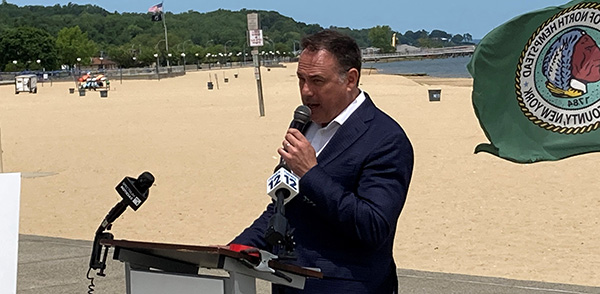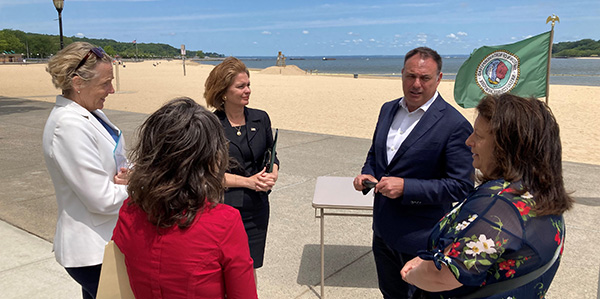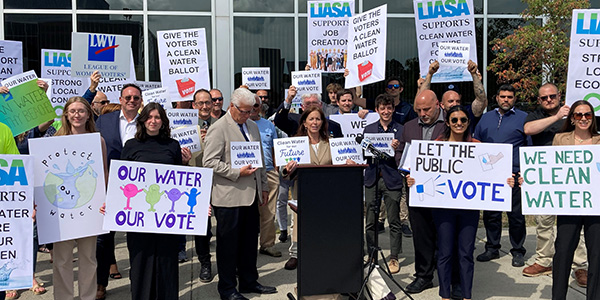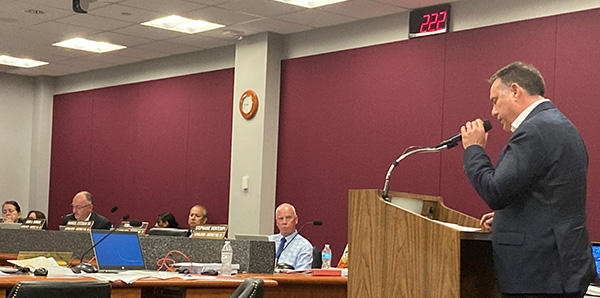
Last Wednesday, June 21, was the longest day.
That’s not hyperbole. The sun rose over West Shore Road at 5:23 a.m. and didn’t slide beyond the horizon until 8:30 p.m., giving the people of Port Washington, NY, a full 15 hours and seven minutes of daylight – more than they’ll enjoy on any other day in 2023.
For our Vice President of Water Protection, though, it was the longest day – the fullest day – for reasons that had nothing to do with the summer solstice.
David Ansel‘s day started on the road, early enough to beat New York City commuter traffic to the Throgs Neck Bridge. He was bound for North Hempstead Beach Park, where members of his water quality team would host one of two simultaneous press conferences (the other at Lighthouse Point Park in New Haven, CT) heralding the release of the 2023 Long Island Sound Beach Report. It’s always a big day when Save the Sound rolls out one of our reports, especially this one. People across the region are always interested in finding out how the water has been at their favorite Sound beaches, and particularly so on the first day of summer.
The solstice – the point when the sun is highest in the northern sky – arrived at 10:58 a.m. A few minutes later, David was at the podium, welcoming the gathered members of the media, many Nassau County officials and their staff, other partners and supporters, and the audience following the press conference on our Instagram livestream, all of whom shared an interested in the answer to the question we’re always asked: How’s the water?
“There was a time not long ago when many people wouldn’t swim in Long Island Sound,” David said early in his remarks, as flags whipped in the wind behind him. Caroline, one of our Healthy Waters interns this summer, clutched a stack of 2×3′ posters featuring charts from the Beach Report, keeping them from taking flight. “They were reading reports of poor water quality in the Sound overall, hearing reports of fish die offs, and large volumes of intreated sewage entering our waters. Thanks to years of advocacy and investment by environmental leaders like Save the Sound, municipal governments, the states of Connecticut and New York, the EPA, and concerned shoreline residents, the Sound is now ringed with many beaches that consistently provide water quality meeting safe swimming criteria.”
David highlighted the good news provided by the Report: 78% of the 207 Long Island Sound Beaches, both public and private, received “A” or “B” grades, based on data from the 2022 swimming season. But there was also bad news to deliver.
“That means 22% are getting ‘Cs’ or lower, and this is not acceptable.”
David brought Sam Marquand, our clean water advocacy specialist, to the podium to detail the full findings of the Beach Report, explain the science and data that determine the grades, and elaborate on the primary challenges to water quality common to many Sound beaches: wastewater and stormwater. When the press event, one-on-one interviews, and a fruitful huddle with partners from the Town of North Hempstead and Coalition to Save Hempstead Harbor were all complete, it was time to continue heading east.

Soon David was back on the Long Island Expressway, bound for a Rally for Clean Water and a crucial public hearing at the Suffolk County Legislature in Riverhead. He planned to testify in support of adding the Suffolk County Water Quality Restoration Act to the November ballot. The Act would allow voters the opportunity to support a 1/8 cent increase of county sales tax to fund a program that would help the county reduce nitrogen pollution emanating from 380,000 outdated and inadequate cesspools and septic systems. A related bill would consolidate Suffolk County’s 27 sewer districts. Two bills, both addressing the greatest threats to water quality outlined in the Beach Report. The evening hearing would provide a perfect complement to the morning’s press event.
In the interim, though, as David ate his sandwich and chewed up miles of the eastbound LIE, an email alert pinged: Senate Bill “S5186A has been substituted for A5221A.” That meant that up in Albany, on the afternoon of the second day of a two-day special session of the New York State Assembly, the Living Shorelines bill had passed. Our top legislative priority of the last two New York sessions had already passed the Senate (twice, actually, needing to pass a second time after the bill was returned by the Assembly and amended), and now it will be bound for the signature of Governor Kathy Hochul.
“We are thrilled that it passed the Assembly this afternoon,” David said in comments crafted from a parking space outside the Evans K. Griffing Building in Riverhead for a press statement about the bill, which authorizes and encourages the use of nature-based solutions as the state’s preferred alternative for stabilizing New York’s tidal shorelines. “Throughout the process, Save the Sound has worked closely with Assemblyman Steve Otis and Senator Shelley Mayer, the bill’s sponsors in their respective chambers and two environmental champions. We will continue to work with policymakers to encourage Governor Hochul to sign into law this legislation that will benefit New York’s coastline and coastal communities on Long Island Sound.”
The already-long day was turning into a banner day. And it wasn’t yet half over.

At 3:30 p.m., David grabbed a small sign that read, “Our Water Our Vote” and stepped into a crowd of advocates and stakeholders outside the building where the county legislature was already in session. A steady parade of supporters – including an impressive and persuasive student, just two days before Brentwood High School graduation – took their turn at the microphone, emphasizing the importance of clean water to the residents and businesses of Suffolk County and the necessity of allowing the voters a voice in their own clean water future. Suffolk County voters have proven themselves strong supporters of environmental investment, with 64% of them voting for the $4.2 billion Environmental Bond Act last November, so getting clean water onto the ballot for this November would be an encouraging step.
To be on the ballot, the bill first had to be approved by the state legislature. Step one, done: it was included in the New York State Budget for Fiscal Year 2024. The second hurdle was the 16 elected officials gathered around The Horseshoe inside the Griffing Building.
By the time the public hearing began, David had been joined in the packed gallery by Louise Harrison, our Long Island Natural Areas Manager. Ninety minutes after public testimony began, the legislature voted 10-6 to recess, sending IR 1512 – which would consolidate the county’s 27 sewer districts – back to committee. That makes it unlikely to be included on the November ballot.
The air in the gallery shifted. The optimism that fueled the rally flushed from the room, deflated by the party line vote. One more bill remained on the agenda – IR 1573, which would create a sustainable funding source for the Water Quality Restoration and extend the Suffolk County Drinking Water Protection Program. And the gathered leaders from environmental, labor, industry, and business groups knew they were in for a fight.
It was into this simmering scene that David stepped up to his second podium of the day, 60 miles and nearly 10 hours from the first. This time would be no day at the beach.

David was the first of more than three dozen people to testify, all of whom spoke in support of IR 1573. He used his full three minutes, talking about the urgency of clean water and reminding the elected officials that their constituents were clamoring to be heard.
At 10:30 p.m., when the presiding officer noted there were still 25 people waiting to provide testimony, it was time to call it a day. David faced the drive back to Westchester County, a return trip extended by construction that shut the LIE unannounced and forced a six-mile backup on service roads.
It was a fitting end to an evening that brought the day’s impressive progress came to a halt. While David sat in traffic, IR 1573 was decided by another party line vote. It was sent back to the Budget and Finance committees shortly before midnight, bringing an end to the longest day of the year.
